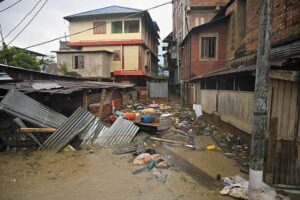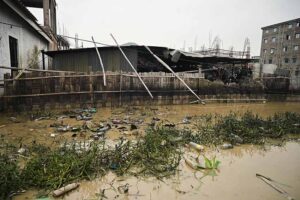Manipur has been at the receiving end of multiple floods due to Cyclone Remal and inecassant rainfall since late May. Major valley districts such as Imphal East, Imphal West, Thoubal, Bishnupur, Kakching have all been affected, producing as an aftermath a large pile of “disaster waste”.
Northeastern state of India has been reeling under severe stress due to floods. This year unprecedented floods of large scales have occurred in Manipur and Tripura albeit Assam where flood occurs every year. With changing patterns of rainfall, rapid urbanisation, deforestation and climate change in the region, susceptibility to disasters such as flood would likely increase more in the coming years. Many have remarked, floods that have recently occured or are currently occurring in Manipur and Tripura are one of the worst of its kind.
In Manipur, floods this year started as an aftermath of Cyclone Remal that hit the Indian Continent during the month of May. The first wave of flood due to Cyclone Remal affected mostly Imphal East, Imphal West and Kangpokpi District. As of 31st May, 2024 it was reported that a total of 188,143 people were affected along with at least 24,265 houses damaged, 18,103 people evacuated and 56 relief camps were set up due to the floods. In less then a month span, another severe flood occurred as incessant rain resulted in overflow of major rivers like Thoubal and Iril. Cometh August first week another wave of floods occurring in Churachanpur and Bishnupur Districts rendered Internally Displaced People (people who have been displaced from their homes due to the 16 month long ethnic conflict in the state) homeless yet again. A few weeks later, Thoubal and Kakching districts have also been affected by the latest round of floods. In Thoubal District alone, more than 1000 flood affected persons are sheltered in 11 relief camps. Fear of further flooding in Manipur remains until the end of monsoon rains.
Residues of Disasters
Post any natural or human-made disasters, depending upon the built environment where it occurred, it produces residual “disaster waste”. Debris and waste generate post floods, landslide, earthquake, fire etc are thus termed as disaster waste. The presence of it impacts every aspect of emergency response and recovery efforts. Further if not timely cleared, it becomes a possible breeding ground for vector and hence poses a potential public health risk. Discourse on disaster waste management remains one of the most overlooked subjects. Handling of disaster waste requires scientific management, technical expertise. Global experiences suggest that Disaster Waste Management plans seldom exist. Similarly Manipur and India do not have one.

As intensity and frequency of natural hazardous events such as floods, landslides, earthquakes and cyclones are evidently increasing in the world and the Indian subcontinent is no exception. In lieu of the growing disaster, the National Institute of Disaster Management (NIDM), after consultative meetings and thorough literature review of global experience in handling waste post disaster, came up with a report on 2023. The report titled “Solid Waste Management in Post-Disaster Situations 2023” flags the needs for a pre-disaster solid waste contingency plan, post disaster solid waste management implementation plan. It lays out the Immediate, Short, Medium and Long term plans to handle disaster waste rather that the usual reactive and ad-hoc measure taken up post a disaster. An “institutionalise proactive approach” by setting up proper institutional mechanics along with contingency planning, emergency support function etc are suggested by the report and hence an urgent need for “developing a ‘Disaster Waste Management Plan’ and its implementation machinery”.
The Manipur experience of handling post flood waste signals a similar story on the needs for an integrated disaster waste management plan.
Experiences of handling Disaster Waste in Manipur Floods
The Imphal Municipal Council(IMC) along with its partner NGOs and women self-help groups collects municipal and solid waste from 27 Urban Local Bodies (made up of 305 wards) regularly and dumps it at the Lamdeng Waste to Energy Plant at the outskirts of Imphal West. The Lamdeng WTE was planned to process 100 metric tonnes everyday. Whereas “IMC alone collects on an average of 110-120 MT per day” remarks Peter Yumnam, assistant municipal commissioner. Although a proper collection mechanism exists, there is a lack of processing capacity of the waste that is collected everyday.

A report accessed by DownToEarth reveals that 2,386.995 metric tonnes of waste were collected from 1st June to 11th June; the first phase of the floods by IMC alone. Normally IMC issues 320 litres of diesel everyday for its machineries operations, however during this span of 11 days of heavy intensive clean up, it issued almost 6000 litres of oil. The post flood disaster waste profile includes vegetative waste, plastics, mattress, clothes, food packets, sludge, etc. “Loading had to be done using excavators as the disaster waste is wet, heavy and contains all short of hazardous materials, we had to carry on this clean for almost 2 months since June with no additional support” Yumnam added. The report further added the Lamdeng Solid Waste Management plant has seen an increase of 2.5 to 3 times of waste received.
Waste collectors such as NGOs and women self help groups too were overwhelmed with collection of waste during the floods. “What normally use to take 1 trip to cover was now multiplied to 2-3 trips of collection and since all the waste were soaked in water, our trucks broke down a lot” Sananu Rajkumari of Chingmeirong Maning Leikai Nupi Chaokhat Lup told DownToEarth. With the increased collection by private entities along with the 2.5-3 times reported increase collection done by IMC, the total waste collected and dumped at Lamdeng exceeds much much more that its handling capacity. The piling of this disaster waste would create a huge amount of “legacy waste” which are known to have detrimental effects on both environmental and public health. Moreover legacy waste is known to produce greenhouse gases which are one of the lead causes of climate change. “It was a very difficult experience of handling the disaster waste and as the likelihood of more disaster occurrence increases, a proper plan needs to be laid out” exclaims Yumnam.
Further, what is stressing is that the collection is mostly limited to the urban areas. Hence, post-flood disaster waste in rural areas, which constitutes a larger area as compared to the municipal areas, have been either left to rot, or are dumped in landfill dug out by the themselves or are most likely openly burnt.
This article first appeared in DownToEarth
(The article is filed under the 5th State level Media Fellowship Programme on Climate Change under the sponsorship of the Directorate of Environment and Climate Change, Government of Manipur.)

The writer is an environment enthusiast and specializes in climate change impacts and related issues











